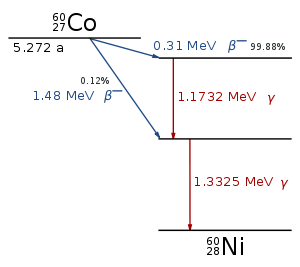Gamma (![]() )rays are produced during radioactive decay along with other forms of radiation such as alpha or beta, after the other types of decay occur. When a nucleus emits an
)rays are produced during radioactive decay along with other forms of radiation such as alpha or beta, after the other types of decay occur. When a nucleus emits an![]() or
or![]() particle, the daughter nucleus is usually left in an excited state. It can move to a lower energy state by emitting a
particle, the daughter nucleus is usually left in an excited state. It can move to a lower energy state by emitting a![]() ray, in much the same way that an atomic electron can jump to a lower energy state by emitting infrared, visible, or ultraviolet light.
ray, in much the same way that an atomic electron can jump to a lower energy state by emitting infrared, visible, or ultraviolet light.
First![]() decays by beta emission to excited
decays by beta emission to excited![]() which decays to the ground state by emitting two gamma rays (1.1732 MeV and 1.3325 MeV):
which decays to the ground state by emitting two gamma rays (1.1732 MeV and 1.3325 MeV):

The sharply defined frequencies of gamma rays emitted from the nucleus reveals that nuclei can have energy levels in the same ways as electrons in the shells around atoms. Some nuclei have energy levels more complex than others, implying that the protons and neutrons in the nuclei may form shells.
